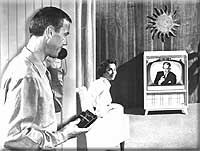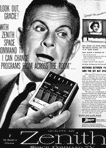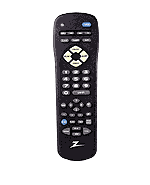|
Channel surfing was born five decades ago. The first TV remote control, called "Lazy Bones," was developed in 1950 by Zenith Electronics Corporation (then known as Zenith Radio Corporation). Lazy Bones used a cable that ran from the TV set to the viewer. A motor in the TV set operated the tuner through the remote control. By pushing buttons on the remote control, viewers rotated the tuner clockwise or counterclockwise, depending on whether they wanted to change the channel to a higher or lower number. The remote control included buttons that turned the TV on and off. Although customers liked having remote control of their television, they complained that people tripped over the unsightly cable that meandered across the living room floor. Commander Eugene F. McDonald Jr., Zenith's late founder-president, believed TV viewers would not tolerate commercials and was convinced that sooner or later commercial television would collapse. While waiting for the development of commercial-free subscription television, McDonald yearned for a wireless remote control that would mute the sound of commercials.
Zenith engineer Eugene Polley invented the "Flashmatic," which represented the industry's first wireless TV remote. Introduced in 1955, Flashmatic operated by means of four photo cells, one in each corner of the TV screen. The viewer used a highly directional flashlight to activate the four control functions, which turned the picture and sound on and off and changed channels by turning the tuner dial clockwise and counter-clockwise. While it pioneered the concept of wireless TV remote control, the Flashmatic had some limitations. It was a simple device that had no protection circuits and, if the TV sat in an area in which the sun shone directly on it, the tuner might start rotating. Development Challenges Commander McDonald loved the concepts proven by Polley's Flashmatic and directed his engineers to develop a better remote control. First thoughts pointed to radio. But, because they travel through walls, radio waves could inadvertently control a TV set in an adjacent apartment or room. Using distinctive sound signals was discussed, but Zenith engineers believed people might not like hearing a certain sound that would become characteristic of operating the TV set through a remote control. It also would be difficult to find a sound that wouldn't accidentally be duplicated by either household noises or by the sound coming from TV programming. Regardless of the specific system chosen, Zenith sales people were against using batteries in the remote control. In those days, batteries were used primarily in flashlights. If the battery went dead, the sales staff said, the customer might think something was wrong with the TV. If the remote control didn't emit light or show any other visible sign of functioning, people would think it was broken once the batteries died.
Zenith's Dr. Robert Adler suggested using "ultrasonics," that is, high-frequency sound, beyond the range of human hearing. He was assigned to lead a team of engineers to work on the first use of ultrasonics technology in the home as a new approach for a remote control. The transmitter used no batteries; it was built around aluminum rods that were light in weight and, when struck at one end, emitted distinctive high-frequency sounds. The first such remote control used four rods, each approximately 2-1/2 inches long: one for channel up, one for channel down, one for sound on and off, and one for on and off. They were very carefully cut to lengths that would generate four slightly different frequencies. They were excited by a trigger mechanism - similar to the trigger of a gun - that stretched a spring and then released it so that a small hammer would strike the end of the aluminum rod. The device was developed quickly, with the design phase beginning in 1955. Called "Zenith Space Command," the remote went into production in the fall of 1956, becoming the first practical wireless remote control device. Quarter Century of Ultrasonic Remotes The original Space Command remote control was expensive because an elaborate receiver in the TV set, using six additional vacuum tubes, was needed to pick up and process the signals. Although adding the remote control system increased the price of the TV set by about 30 percent, it was a technical success and was adopted in later years by other manufacturers. In the early 1960s, solid-state circuitry (i.e., transistors) began to replace vacuum tubes. Hand-held, battery-powered control units could now be designed to generate the inaudible sound electronically. In this modified form, Dr. Adler's ultrasonic remote control invention lasted through the early 1980s, a quarter century from its inception. More than 9 million ultrasonic remote control TVs were sold by the industry during the 25-year reign of Dr. Adler's invention.
By the early 1980s, the industry moved to infrared, or IR, remote technology. The IR remote works by using a low frequency light beam, so low that the human eye cannot see it, but which can be detected by a receiver in the TV. Zenith's development of cable-compatible tuning and teletext technologies in the 1980s greatly enhanced the capabilities and uses for infrared TV remotes. Today, remote control is a standard feature on other consumer electronics products, including VCRs, cable and satellite boxes, digital video disc players and home audio receivers. And the most sophisticated TV sets have remotes with as many as 50 buttons. In 2000, more than 99 percent of all TV sets and 100 percent of all VCRs and DVD players sold in the United States are equipped with remote control. |


